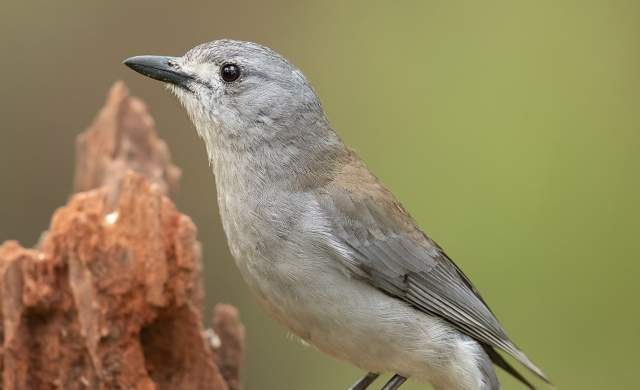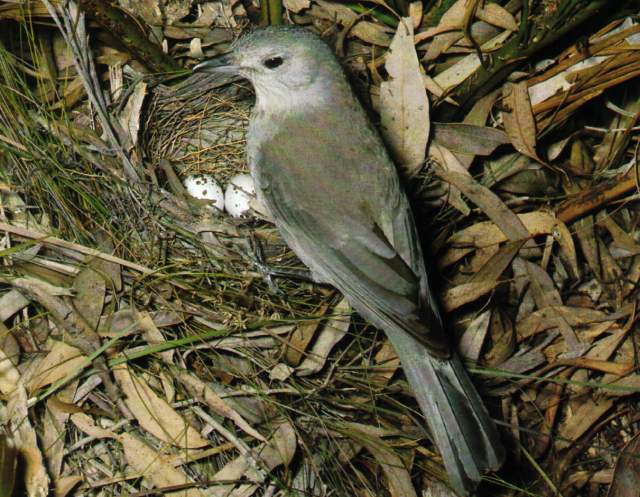Family: The Grey Shrike-thrush (Colluricincla harmonica) is a well-named harmonica in the world. It belongs to the family Pachycephalidae.
Alternative Names: It is also known as Grey Thrush, Western Shrike-thrush, Brown Shrike-thrush, Buff-bellied Shrike-thrush, Harmonious Shrike-thrush, Whistling Shrike-thrush, and Whistling Dick.
Size: In terms of length, the Grey Shrike-thrush measures 220-240 mm.
Habitats: It is a common and familiar bird in most regions but has retreated into undisturbed bush-land except in southeastern Australia. The Grey Shrike-thrush forages through all strata of its habitat with purpose. Among the foliage and along the upper branches, they poke in crevices and under leaves, work over the trunks of trees, pulling away bark to expose prey, and bound over the ground, gleaning among litter and logs. The Grey Shrike-thrush is sedentary. A pair of established birds can stay within a territory of about two hectares all year long or may venture a little further afield in the winter. It is generally young birds who travel more widely, after being expelled from their parental territories, is unattached.

Diet: A wide variety of insects and spiders, lizards, small mammals, nestlings of other birds, and even carrion are eaten by them.
Flight: The bird’s flight is characterized by swooping undulations and little flapping, usually through the woodland on the mid-stage.
Identification: On the male upper parts, the color ranges from a deep grey to a mid-brown or a mid-grey on the crown and the rump, with an olive-brown mantle. Lores white; eye-ring dark. Its underparts are light grey-white, washed darker on the breast, or with cream-buff suffusion, and on the belly and undertail, it becomes rufous-buff. The eyes are ruby color. There is a black bill. There is a dark grey color to the feet. There is a white eye ring on the female; Lores Grey on the male; a grey throat and breast on the female; and a gray-brown bill on the male. Immature wings have washed rufous primary coverts; underparts are streaked notably; young males have less streaking and dusky bills; eye brown. A second or third year’s adult plumage.
Vocalizations: There are times when its melodious notes can carry for over half a kilometer because it is strong, pure, and rhythmic. When breeding, males sing continuously from open vantage perches beneath the tree canopy throughout the day at intervals throughout the day. Males sing sporadically throughout much of the year, especially during the early morning. Throughout Australia, Grey Shrike-thrushes inhabit open woodlands and forests of all types; only rain-forests and treeless deserts are excluded.
Call: Grey Shrike-thrush calls single, strident, whistled yorrik or ching, sharply by both sexes in contact. Also short, harsh descending cackle of two-three notes.
Song: The song of Grey Shrike-thrush is a clear, melodious sequence of whistled notes- purr-purr-he -whew-it and pip-pip-pip-pip-hoeeee the last syllable usually rising high. Often given by both sexes in call-and-answer duets.
Nest & Breed: Nesting and breeding take place between July and February. Nests are bowl-shaped and made of bark strips, plant fibers, and coarse grass; placed in stump hollows, log hollows, on broken branches, in upright tree forks, crevices in buildings, eroded creek banks, rock ledges, thick shrubs, or even on the ground.
Eggs & Incubation: Grey Shrike-thrush lays three eggs, occasionally four; white or cream, sparsely but clearly blotched or spotted with dark olive-brown and grey; oval, about 28 x 20 mm. The incubation period is about 16-18 days for both sexes. Most broods are raised by both sexes, with both building nests, incubating eggs, and rearing the young.
Distribution: Grey Shrike-thrush is widespread in woodlands and open forests throughout Australia. Also found in eastern Papua New Guinea. The western and central populations have grey-brown backs and russet-vented birds; the Cape York Peninsula and New Guinea populations have greyer backs and prominent white eyebrows; and the eastern populations have olive-brown backs and white vents.
Races: There are five races, and all are found in Australia. Although several of the five races in Australia have been classified as separate species, they all intergrade, except for the Tasmanian race, which has a thin, dagger-like bill.
Read More – Blue whistling thrush (Myophonus caeruleus)







